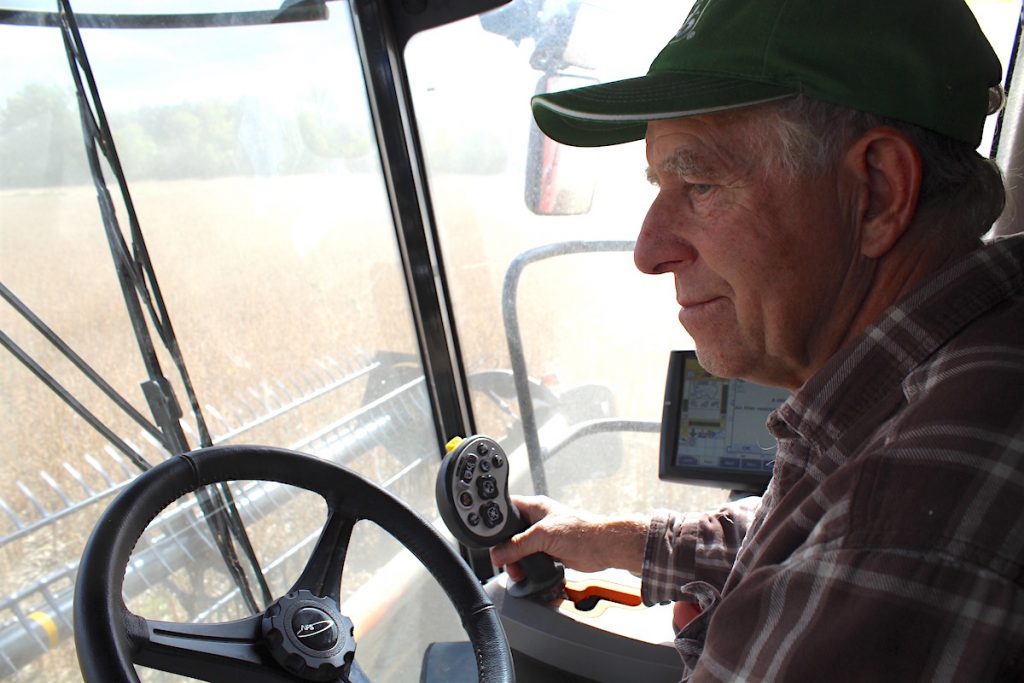ASHLAND, Ohio — Although the crops are maturing early in many places, getting into the fields has been a challenge for some area farmers.
Ashland County farmer David Eichelberger has been going back and forth between harvesting beans and corn, “depending on the weather” and the day of the week. He told Farm and Dairy he’s making good progress with both, seeing corn yields consistently within the 190-200 bushel per acre level.
However, the early fall weather has been a bit of a challenge, coupled with wet field conditions and low commodity prices.
In Ohio, 47 percent of corn was harvested as of Oct. 21, according to the National Agricultural Statistics Service, and 58 percent of soybeans were harvested. In Pennsylvania, 37 percent of corn is harvested, and 28 percent of soybeans were harvested.
Mold issues
Charles L. Kettering, also an Ashland County farmer, said he’s seeing some mold starting to show up in the soybeans because it’s taken so long for them to dry down. He was finally able to harvest some beans within the 12-13 percent moisture range Oct. 19, but he said there are still places where some beans are green.
The cool nights of the past week brought temperatures in the low 30s, and some frost, which many farmers were hoping would come, to kill the corn and soybeans still in the fields.

Joel Hunter, an Extension educator from Crawford County, Pa., said silage harvest is mostly complete, but farmers in western Pa. are finding it hard to get corn and soybeans harvested.
“The main thing is the moisture,” he said. “Its just mainly trying to pick your time so you’re not tearing things up.”
Hunter said there have been some disease issues with the crops, but not as much as had been expected earlier. He said yields in his area seem decent — not record-breaking — but good overall.
In the field
Mark McConnell, of Hickory Grove Farms in Lorain County, took Farm and Dairy on a combine harvest ride Oct. 24. He was harvesting a field of Plenish soybeans, a special variety developed by Pioneer, and used in the food oil business.

McConnell said he was seeing excellent yields in Medina and Lorain counties, and his brother, Jim McConnell, was seeing the same at their western Ohio farm, near Van Wert. The biggest problem has been getting enough dry days in one stretch, to make a serious stride.
“If we get a nice big stretch of weather where we could really get rolling, that would keep everybody happy, and tired,” he said.
Making the best
The strong yields and the lack of trade with other countries has put significant down pressure on this year’s prices, but Mark said farmers just have to make the best, and hope it gets better.
“Marketing is marketing,” he said. “You just have to do whatever you can with whatever you have to work with.”
According to a recent article by Ohio State university’s Agronomic Crops Network, leaving corn in the field past maturity increases the risk for weather-related damage. Soybeans also face increased risk as fall continues, a fact farmers know and that research has proven.
Ear drop and ear rot are all concerns with corn, and soybeans can mold and deteriorate, as well.
(The following is some basic research findings from Ohio State University, related to late-harvested corn.)
- Results showed that nearly 90 percent of the yield loss associated with delayed corn harvest occurred when delays extended beyond mid-November.
- Grain moisture decreased nearly 6 percent between harvest dates in October and November. Delaying harvest after early to mid Nov. achieved almost no additional grain drying.
- Higher plant populations resulted in increased grain yields when harvest occurred in early to mid-October. Only when harvest was delayed until mid-November or later did yields decline at plant populations above 30,000/acre.
- Hybrids with lower stalk strength ratings exhibited greater stalk rot, lodging and yield loss when harvest was delayed. Early harvest of these hybrids eliminated this effect.
- The greatest increase in stalk rot incidence came between harvest dates in October and November. In contrast, stalk lodging increased most after early-mid November.
- Harvest delays had little or no effect on grain quality characteristics such as oil, protein, starch, and kernel breakage.









